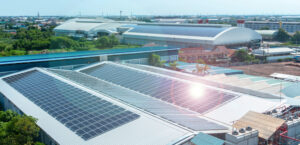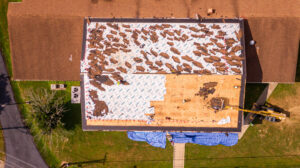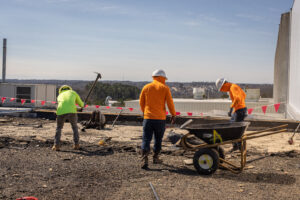Historical roofing is vital for us to maintain a tangible connection to our past. It involves conserving and protecting buildings, objects, landscapes, and other artifacts of historical significance. One of the key aspects of historical preservation, often overlooked, is roofing. This blog post will delve into the importance of roofing in historic preservation, using the case study of the Vanderbilt University Gymnasium project undertaken by our commercial roofing company, Eskola Roofing.
What is Historical Preservation in Roofing?
Historical preservation is protecting and preserving sites, structures, and buildings with historic roofing materials. These could range from ancient ruins to more modern structures with cultural or architectural importance. The goal is to maintain the integrity of these sites and structures, allowing future generations to appreciate and learn from them.
The Challenges of Roofing in Historical Preservation
Roofing materials play a crucial role in historic preservation. The roof of a building is not only a critical structural component but also contributes significantly to its aesthetic and historical value. However, roofing in historical preservation presents several challenges:
- Matching Historical Materials and Styles: Historical buildings often have unique architectural styles and were built using materials that may no longer be readily available. Finding matching materials and replicating historical styles can be complex and time-consuming.
- Structural Issues: Older buildings often have structural issues that must be addressed during roofing. These can include weakened or damaged structural elements that must be repaired or reinforced.
- Building Codes and Preservation Laws: Historical buildings are often subject to specific building codes and preservation laws that limit the types of materials and methods used in roofing.
- Balancing Modern Efficiency and Historical Accuracy: While it’s important to maintain the historical accuracy of a building, it’s also necessary to ensure that the building is safe, functional, and energy-efficient. This often requires a careful balance between modern roofing techniques, materials, and historical authenticity.
Materials Used in Historical Roofing
Historical buildings often feature unique historic roofing materials contributing to their architectural style and historical value. Some of the most common materials used in historical roofing include:
- Slate: Slate is a durable and long-lasting material that has been used in roofing for centuries. It is known for its natural beauty and is often used in historic buildings.
- Clay Tiles: Historic tile roof is another traditional roofing material. They are durable, fire-resistant, and available in various colors and styles.
- Wood Shingles: Historic roof shingles were commonly used in historic buildings. They provide a natural and rustic look but require regular maintenance to prevent decay and damage.
- Metal: Historic metal roofing, particularly copper, has been used in roofing for centuries. It is durable, fire-resistant, and weathers to a beautiful patina over time.
In the Vanderbilt University Gymnasium project, the main requirements were to replace roofing on 17,000 square feet, including fish scale slate, regular slate, and copper finials.
Techniques for Historical Roofing
Historical roofing requires specialized techniques to ensure that the integrity and authenticity of the building are maintained. These techniques often involve traditional methods that have been passed down through generations of craftsmen. Here are some of the techniques used in historical roofing:
- Removal of Old Roofing: The first step in any historical roofing project is carefully removing the old roofing. This process must be done delicately to avoid causing any damage to the underlying structure. Many of the wood slats in the Vanderbilt University Gymnasium project were original and dated back to the 1800s. They were installed with hand-made nails, which had to be cut out to remove old slats.
- Creation of Custom-Made Materials: Historical roofing often requires custom-made materials to match the original roofing. In the Vanderbilt project, workers were sent north to the slate manufacturer to create custom-made slate tiles that matched the university’s specifications.
- Installation of New Roofing: The installation process in historical roofing is often complex and time-consuming. It requires a high level of skill and attention to detail. In the Vanderbilt project, the new slate tiles and copper finials were installed by hand, and each joint had to be hand-soldered.
Modern Innovations in Historical Roofing
While historical roofing often involves traditional techniques and materials, modern innovations can also play a role. These innovations can help improve the roof’s efficiency and durability while still maintaining the historical authenticity of the building.
- Use of Modern Materials: Modern materials like modified bitumen can be used in historical roofing to provide a durable and long-lasting surface. In the Vanderbilt project, the roofers covered the low, flat roof with garland-modified bitumen.
- Use of Technology: Modern technology, such as drones and 3D imaging, can be used to assist in the planning and execution of historical roofing projects. These technologies can help identify potential issues and ensure the roofing is installed correctly.
Navigating Building Codes and Preservation Laws
Historical roofing projects often involve navigating a complex web of building codes and preservation laws. These regulations are designed to protect the historical integrity of the building, but they can also pose challenges to the roofing process. It’s important to work closely with local historical societies and preservation boards to ensure that all work complies with these regulations.
The Importance of Regular Maintenance and Inspection
Maintaining the integrity of a historical roof is a task that requires consistent attention and care. The longevity and performance of a historical roof are directly tied to the regularity and thoroughness of its maintenance and inspection. This is not only crucial for preserving the aesthetic and historical value of the building but also for ensuring its safety and functionality.
Regular Inspections
Regular inspections are a proactive approach to historical roof maintenance. They allow for the early detection of potential issues that could escalate into significant problems if left unattended. These inspections should be carried out by roofing contractors with expertise in identifying the unique challenges that historical roofs often present.
Inspections typically involve a comprehensive assessment of the roof’s condition, including the examination of roofing materials, gutters, downspouts, flashing, and other components. Special attention should be given to signs of wear and tear, water damage, structural issues, or any other abnormalities.
In addition to routine inspections, it’s also important to conduct inspections after severe weather events. High winds, heavy rain, hail, or snow can cause immediate and noticeable damage to the roof. Early detection of such damage can prevent further deterioration and costly repairs.
Regular Maintenance
Regular maintenance complements the findings of regular inspections. Once potential issues are identified, timely maintenance can address these problems and prevent them from escalating.
Maintenance of a historical roof can involve a variety of tasks, depending on the materials used and the specific issues identified. This can include cleaning the roof to remove debris, moss, or algae that could potentially damage the roofing materials over time.
Repairing damage is another critical aspect of maintenance. This could involve replacing roof shingles or tiles that are cracked, broken, or missing, repairing leaks, or addressing any structural issues that may have been identified during the inspection. Historical roofs can also be susceptible to storm damage. Learn about the Signs of Storm Roof Damage.
In some cases, maintenance may involve the replacement of worn or damaged materials. For instance, if a metal roof on a historic home shows signs of corrosion, it may be necessary to replace the affected sections to prevent further deterioration.
Regular maintenance and inspection are not just optional activities but essential practices for the preservation of historical roofs. They help ensure that the roof continues to perform its protective function effectively while maintaining the historical authenticity of the building. By identifying and addressing potential issues early, these practices can extend the life of the roof, preserve the building’s historical value, and save on costly repairs in the long run.
Case Study: Vanderbilt University Gymnasium Project
The Vanderbilt University Gymnasium project is a prime example of the complexities and challenges involved in historical roofing. This project involved replacing the roof on several historic buildings at Vanderbilt University in Nashville, Tennessee. The project required custom-made materials and careful attention to detail to preserve the integrity of the buildings.
The project took a full year to complete and involved the replacement of 17,000 square feet of roofing, including fish scale slate, regular slate, copper finials, and gutters and downspouts. The new roofing combines modified bitumen, slate, and copper to provide a durable, long-lasting surface that maintains the buildings’ historical authenticity. The historic metal roof shingles and standing seam metal roofs were particularly challenging to install but were crucial in maintaining the historic look of the buildings.
Historical roofing overall protects the building from the elements and contributes to its architectural style and historical value. While historical roofing can be challenging, it is also a rewarding endeavor that helps to preserve our connection to the past. The Vanderbilt University Gymnasium project is a prime example of the complexities and rewards of historical roofing, demonstrating how modern techniques and materials can be combined with traditional craftsmanship to preserve the integrity of historic buildings. As a leading commercial roofing company, Eskola Roofing is proud to have been a part of this important project.






